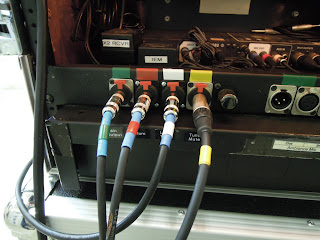No, what I'm referring to is the idiot moves that we all make when we're rushed, tired, drunk, or are just having a day where we're suffering from cranial rectosis. You know, like whenever you have a show to do.
Hooking up a sound system offers literally a hundred or more opportunities to plug something in wrong. The well engineered and packaged system will remove as much "thinking" from the process as can be practically achieved. If the connections are intuitive, logical, and give the proper cues to the person hooking it up, you can save yourself a lot of time and frustration.
Last week, we talked about wiring bundles...putting cables with a common source and destination together. That's all great, but what about when you have 4 or 5 connectors on each end...what do you do?
This is where careful labeling and connector selection come into play.
So, if it's really late (or early) and you've had a few drinks, could you hook this up?
If you can still match up colors, yes you can!
Don't get me wrong, text is still a darned handy thing to have when you're troubleshooting a problem. And sometimes, you have to hook up to systems other than yours..."Red" won't mean anything to a house sound man, but "KC-Vocal Mic" would.
You've just seen a real world example of the "4 x 4" test. If you can hook it up at 4:00 in the morning after 4 beers, it passes. And yes, I personally test each system I assemble this way.
Now, the next question I normally get is "what happens if I do make a mistake hooking it up". The answer is "no damage will occur". It might not work the way you expect, but you're not going to blow anything up. When the guitar shows up on the vocal channel, you can recheck your work, swap cables, and go on with setting up the show.
This is where connector selection is really important. In all of these snakes and bundles that you've seen, similar connectors carry similar signals. In other words, you can't hook the output of an amplifier to the input of a mixer (that would in fact damage the mixer). The worst that happens is you either get no signal or the channels are misassigned. But nothing goes up in smoke.
By the way, here's a complete shot of the back of my main guitar/bass rack I use live:
The cables inside are color coded to where they plug in (just in case something comes loose during transit). You'll also notice that the power supplies on the left side are labelled as to what they are feeding. And I got tired of holding a flashlight every time I went to hook this up...hence the rope light.
Finally, here's a time saver that doesn't have anything to do with cables. When you bring a rack or a case in, there's a 50/50 chance you're going to put it in place facing wrong or open up the side you don't want.
A Sharpie fixes that...
Again, the purpose of all of these exercises is to remove as much "thinking" from set up as possible. A minute here, a couple of minutes there might not seem like much. But trust me, I've seen set up times cut in half just by making things 4 x 4 certified.
Next time, I want to talk about things you should have in your tool box. If you use electricity, cables, or are your own instrument tech then there will be info you can use.
Until then, keep the meters out of the red!
Ken
Ken Carver has been a musician and performer since the early 70's, and involved with live music production since the mid 70's. He worked for 15 years as a broadcast engineer, building numerous studios and transmitter sites around Texas. He's also worked in Critical Care Communications for the medical industry, R&D for an automated lighting manufacturer, and owned Project Lighting & Sound in the 80's. He currently heads up an R&D Hardware Technician Team at National Instruments in Austin, and still performs on the weekends in the Central Texas area. You can reach Ken at kcarvertx@gmail.com






No comments:
Post a Comment